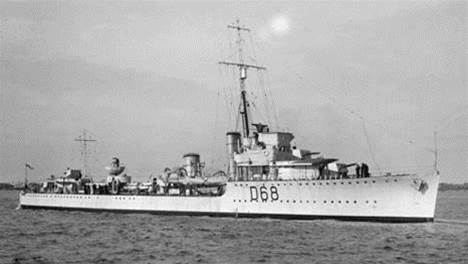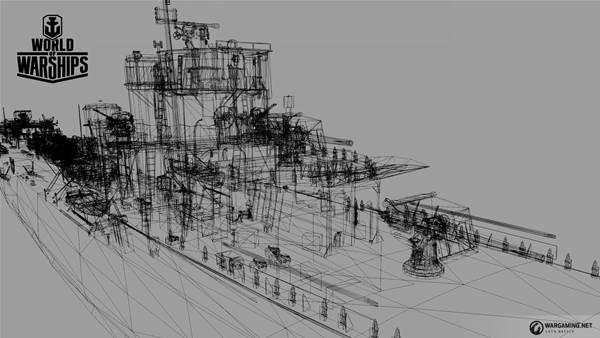Interview: How World of Warships brings historical designs to gaming life
A lot of thought goes into how historical ships are presented in World of Warships.

I recently got a chance to ask a few questions about the process around bringing a real-world ship into Wargaming's World of Warships, speaking to the game's Executive Producer, Artur Plociennik, and Historical Consultant and Museums and Militaria Relations Specialist, Konstantin Kozyuryonok and Sergey Gornostaev respectively.
It's... a little involved!
PCG: When the team first decides to include a new ship in the game, what are the criteria that you’re looking for?
Artur Plociennik: Due to the scope of our project and production planning we acquire a lot of materials and information relating to ships in bulk. Talking with a museum or archive we don’t just get the blueprints for one ship - we try to get everything they have that we believe can be put into the game at one point or another. This means that we have a LOT of different ships and design projects to choose from, when making such decisions. Taking that into account, we usually define a set of traits that we are looking for - like tier, class, nation, as well as a specific type of gameplay - and then see what references we already have or know how to get to fit that set of traits.
A lot of real-world vessels also go through many refits – how do you nail down which version of a ship goes into the game?
Konstantin Kozyuryonok: Reason to choose certain period of time when ship has particular set of armaments might wary [sic] from many factors. Sometimes we even may add to WoWS ships of the same class with alternative weapons. For example, we added German battleship Scharnhorst in as-built configuration while his sistership Gneisenau got main guns - which were proposed to be installed on it in 1943, but the project was not completed due to wartime issues.
Another example is HMS Warspite. This battleship was launched in 1913 even before First World War started. Warspite participated in Jutland battle (31st of May – 1 of June, 1916) – one of the biggest naval battles of 20th century, after which it served until the end of World War II. Naturally, Warspite went through a number of refits. It was something usual for old dreadnoughts of WWI to prolong their service in 1930s and in WWII: new powerful means of destruction were invented and changed tactics of sea battles. This were aviation, surface warning and air search radars, new types of guns and anti-aircraft systems.
The biggest gaming news, reviews and hardware deals
Keep up to date with the most important stories and the best deals, as picked by the PC Gamer team.
In WoW we tend to show this very important technical innovations in upgrades. Players receive new fire control systems and guns, ships become better protected from shells and torpedoes. To sum up in our game warship may “live” for a few decades of history. Sometimes even longer than a historical prototype. You probably know that most of German Navy after WWI have been scuttled in 1919 in Scapa Flow, Scotland. We decided to prolong service of German battleships lost in Scapa Flow and give them modernisations they might have during 20th and 30th.
To create such refits we study history of ship architecture, national Navy shipbuilding specifics, which had every major Navy Power in 20th century.

Once you’ve got a ship dialed in for the game, and it’s one that still exists, do you visit the ship? And if so, what do you do on board to get ready to bring it into the game?
Sergey Gornostaev: Visits to warship museums is probably one of the oldest practices we had as a development team. I compare it with the education of navy sailors. They have mandatory practice on modern vessels and ships of sail too. Almost after the launch of our AAA project, management wisely decided to let key specialists “learn” warships. For that purpose, we launched two big Warship Expeditions as we call it.
During those trips developers visited all four classes of ships presented in WoWS. They met WWII veterans who served on those vessels, took hundreds of photos and worked in ship archives. We also have own hometown ship – Russian cruiser Aurora; each year we launch guided tours for our new employees, we know each corner on that ship and even took part in “battle cruise” when Aurora was towed back to her historical birthplace from the shipyard, where she went through a renovation program. This was first real battle cruise of WoWS employees!
We should mention that practice of photo shooting museum ships is a necessary part of our research process. The Art Department visits ships still in existence and carefully completes a technical photo portrait of a warship. They are interested in quite specific details such as hull-welding, composition of equipment on open bridges (those are visible on our models) and many others. It takes our specialists from two to three days to complete their photo research. In addition, you should know that the list of objects to be studied has more than 100 positions.
During the process, how do you balance real-world characteristics with in-game balance issues?
Artur Plociennik: For some ships the information we have is comprehensive, including everything from the blueprints for the vessel itself, to performance data for its armament and munitions. For some others, the case is quite opposite. However, we still need to follow similar design paradigms and processes, regardless of how much we know about the real-world performance of a ship. Considering World of Warships is not a simulation, we allow ourselves to take certain liberties in terms of translating the behavior of vessels into the game, but we make every effort to hide these liberties or keep them believable for the player, in order to provide a good amount of immersion. For example, while we do assign arbitrary performance values to certain types of armament in the game, we give each a performance bracket, within which we allow ourselves to tweak those values in order to balance a specific ship for its nation, tier level, and the current meta-environment of the game, as well as to provide gameplay differences for ships that were similar in construction, or came from the same class.
To illustrate this, we can compare the HMAS Perth and HMS Leander – two very similar ships, the former being a modified version of the latter. Both ships carry an identical secondary battery of four dual 102 mm/45 QF Mk XIX guns, which have exactly identical in-game characteristics. Both ships also carry the same 533 mm QR Mk IV torpedo launchers, but the in-game stats differ here – the Perth’s tubes reload 10s faster and she has access to a newer Mk IX torpedo. This is to allow her torpedo armament to have more of an impact on the ship’s gameplay style.

Finally, what is the most satisfying part of the process for you, personally?
Artur Plociennik: Personally, I believe the most satisfying outcome is when the romanticised perception or pop-cultural impact of a ship, its engineering characteristics, and the gameplay niche we want to fill all work together. Of course, some ships have a much more popularised story than others, but in many cases even ships that were never finished have a story to their name and carry the hopes and dreams of their makers. Some were built to excel at a specific characteristic, others to directly counter rival nation’s designs – when we manage to depict these nuances inside the game, it gives players a sense that the ship “is as it should be” and that makes it fun.

